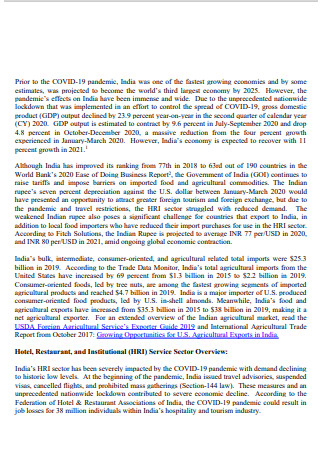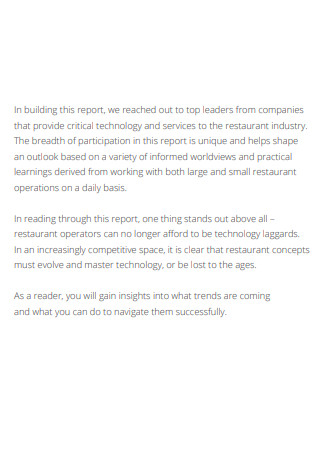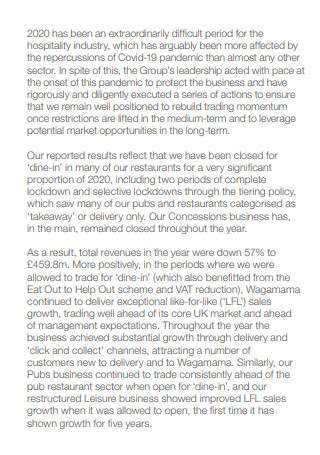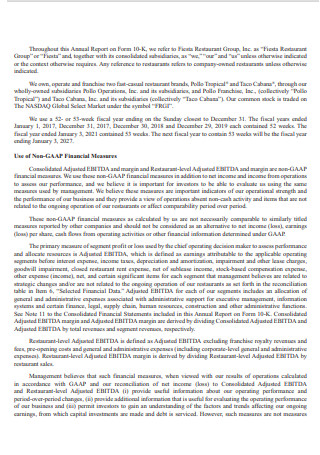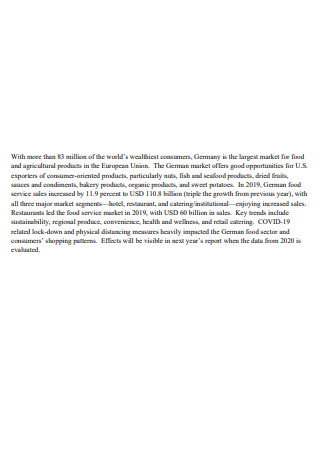4+ SAMPLE Restaurant Business Report
FREE Restaurant Business Report s to Download
4+ SAMPLE Restaurant Business Report
What Is a Restaurant Business Report?
How to Write a Restaurant Business Report
Different Types of Restaurant Business Reports
What Makes an Efficient Business Report?
FAQs
Why bother writing a report on the restaurant business?
Why is it necessary to report in order to run a successful business?
What are the components of a business report?
What Is a Restaurant Business Report?
A Business Report is a compilation of facts and analyses that assists a corporation in making relevant information readily available. There are several forms of company reports, but this tutorial will guide you through the structure of a restaurant business report. Business reports, regardless of size or sector, are vital and necessary tools for any restaurant. They allow you to track and analyze your restaurant’s performance and general health, as well as uncover areas for development and growth potential. As part of a regulatory requirement, certain businesses do require a restaurant financial report. Check out the article’s provided restaurant business report sample.
How to Write a Restaurant Business Report
You might be puzzled as to how to write a restaurant business report, but don’t worry because the rest of the article will guide you through the process. Defining this particular type of report is useful in order to grasp its main use for a Restaurant Business. And with that through, it is time to make one for your own company or business. You can view available templates and even balance sheets for restaurant examples provided in the article and throughout the site. There is also an available restaurant daily report example that you can use as a reference or base.
Step 1: State Purpose and Main Objectives
It’s critical to tailor your objectives to the demands of your target audience. A restaurant business report typically aids in decision-making and tackles specific difficulties. The main objectives of the report can be stated at the start. The material will be better if the purpose is clear and defined. When you convey your aim in a clear and well-defined manner, you won’t waste time altering facts.
Step 2: Gather and Organize the Information
Now that the goal and scope have been established, you may begin collecting data in whatever format that will help you solve the problem. With such information, you will be able to do Data Analysis to learn more about what is beneath the surface and gain useful insights. These conclusions must be fair and reasonable. One of the most significant components of preparing this type of report is identifying key performance indicators for a given company, arranging, comparing, and analyzing them on the required level.
Step 3: Findings
Describe how you discovered them and why you understood them the way you did. Respond to the initial problem by describing the steps to take to solve it and giving advice that will help you make better decisions. The usage of templates, which visually display data in a highly effective manner, is a recommended practice for presenting the insights you have gleaned. When you are trying to figure out what has changed over time, one of the things you might utilize is to compare your results. In today’s digital environment, evaluating discoveries has become one of the key priorities of companies looking to stay competitive.
Step 4: Align your Visualizations
When it comes to how to create a restaurant business report, it’s not only about presenting your results; it’s also about getting the design components perfect. As a general guideline, your most important at-a-glance insights should be at the first section of your document, and you should try to keep your report as clear, simple, and minimum as possible to prevent clutter and misunderstanding. Getting your document design exactly right is critical for improving your visual storytelling and bringing every major part of your report together cohesively. Our comprehensive guide to data visualization techniques will guide you in the correct route.
Step 5: Be Responsive
While current reporting templates are dynamic and interactive in equal measure, developing a business-based report, it’s critical to stay sturdy and responsive. It indicates that the landscape is always shifting in the digital era. As a result, if you want to get the most out of your reports or documents, you must make a commitment to revising and updating them as things change. In an informational setting, what is important now may be obsolete tomorrow, thus your reports must always be optimized for success in order to remain powerful and relevant.
Different Types of Restaurant Business Reports
It takes a lot of effort to run a successful restaurant. While great food and a happy customer experience are crucial, you must also constantly assess and improve your strengths and weaknesses to stay ahead of the competition. Restaurant business reports will allow you to maintain a close check on all of your restaurant operations and make required changes in the areas that aren’t working as well, allowing you to grow your business even more. Since manually keeping track of all restaurant operations is a work that not everyone is capable of, it is strongly suggested that you have an efficient means to write a restaurant business report.
What Makes an Efficient Business Report?
Focus on the topic at hand when writing a business report. The information in the paper should be accurate, timely, and useful to the readers. These are crucial qualities to look for in a good report. A businessperson should not have to wade through pages of fluff text when reading a report to acquire a better grasp of an issue. A strong report communicates with the reader in easy-to-understanding terms.
FAQs
Why bother writing a report on the restaurant business?
Initially, you might be nervous to write a restaurant business report if you have not tried it before. But the good news is with the aid of a template, you are able to spend less time coming up with the structure. Another advantage of restaurant reporting is that today’s technologies and systems provide in-depth, customized data at any time and from any location. You have complete control over whatever metrics are most essential to you and how or how frequently you want to measure them. Quarterly, monthly, daily, and even hourly are all viable options.
Why is it necessary to report in order to run a successful business?
It may seem intimidating to keep track of data and generate reports on a regular basis, but it is really valuable to your business. Reporting insights may help you uncover difficulties and opportunities for development in your company, as well as guarantee that you are on pace to reach your objectives. Instead, a complete restaurant management program can crunch those crucial figures for you, allowing you to swiftly gain a better understanding of your own business. You may acquire insights and take action based on critical analytics and reports. It also interacts smoothly with your existing system, automates orders, and minimizes human error.
What are the components of a business report?
Business reports have a structure with well-defined parts with labels and headings since its objective is to offer facts and clarity. This consistency makes it easy for readers to locate the information they need. A title page, Executive Summary, table of contents, introduction, body part, conclusion, recommendations, references, and appendices are all included in the format of business reports. It may appear that there are a lot of sections, but each one serves a specific role and is necessary for the document’s formal structure. Report writing on restaurants is manageable with a given structure.
Resendes of Upserve stated that in 2018, over 200 million Americans dined at a sit-down restaurant. Such a number would not go down if circumstances continued to operate normally. But since society has gone back to operating in a more normal manner, more and more restaurants are opening their doors to greet their customers. This is why the management team will continuously perform market research to continue the success of their restaurant business. Now that you are aware of how to format a restaurant operations report, you are well equipped to write one for your own business.

